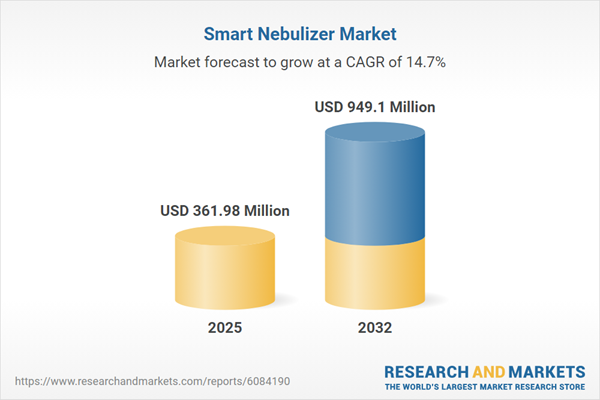Speak directly to the analyst to clarify any post sales queries you may have.
The smart nebulizer market is transforming respiratory care, delivering intelligent, connected solutions that optimize patient outcomes and healthcare efficiency. This sector’s rapid development is guided by innovation, digital integration, and new care models that resonate with forward-thinking healthcare leaders.
Market Snapshot: Smart Nebulizer Market Growth Overview
The Smart Nebulizer Market grew from USD 316.20 million in 2024 to USD 361.98 million in 2025. It is expected to continue growing at a CAGR of 14.72%, reaching USD 949.10 million by 2032. Growth is underpinned by wider adoption of advanced respiratory drug delivery, miniaturization of devices, and the integration of digital health strategies across clinical environments.
Scope & Segmentation: Comprehensive Coverage Across the Smart Nebulizer Value Chain
- Product Type: Jet Nebulizer, Mesh Nebulizer, Ultrasonic Nebulizer
- End User: Ambulatory Surgical Centers, Clinics, Homecare Settings, Hospitals
- Distribution Channel: Offline Channels (Hospital Pharmacies, Retail Pharmacies), Online Channels (E-Commerce Platforms, Manufacturer Website, Third-Party Retailers)
- Disease Type: Asthma, COPD, Cystic Fibrosis
- Region: Americas (United States, Canada, Mexico, Brazil, Argentina, Chile, Colombia, Peru), Europe, Middle East & Africa (United Kingdom, Germany, France, Russia, Italy, Spain, Netherlands, Sweden, Poland, Switzerland, United Arab Emirates, Saudi Arabia, Qatar, Turkey, Israel, South Africa, Nigeria, Egypt, Kenya), Asia-Pacific (China, India, Japan, Australia, South Korea, Indonesia, Thailand, Malaysia, Singapore, Taiwan)
- Leading Companies: Koninklijke Philips N.V., OMRON Corporation, PARI GmbH, Drive DeVilbiss Healthcare LLC, Vyaire Medical Inc., Jiangsu Yuyue Medical Equipment & Supply Co. Ltd., 3M Company, Beurer GmbH, Aerogen Limited, Air Liquide S.A.
Key Takeaways: Strategic Insights for Senior Decision-Makers
- Smart nebulizer systems leverage digital integration, including real-time monitoring, data analytics, and intuitive user interfaces, enabling personalized respiratory care and therapy compliance management.
- Miniaturization and ergonomic device design enhance portability and empower home-based care models, broadening patient access and improving convenience across demographics.
- Collaboration among medical device firms, digital health innovators, and contract manufacturers accelerates innovation pipelines, facilitating rapid product iteration and competitive differentiation.
- Regional strategies are vital; uptake is strongest in mature markets with structured reimbursement, while emerging economies offer growth opportunities driven by public-private partnerships and domestic production scaling.
- Segmentation by device type, care setting, distribution network, and indication informs product roadmaps and ensures effective positioning in distinct clinical and commercial environments.
Tariff Impact: Navigating Supply Chain and Pricing Challenges
Recent U.S. tariff measures have introduced additional costs along global supply chains, prompting manufacturers to reassess sourcing and production strategies. By localizing manufacturing and diversifying supplier bases, industry players aim to sustain pricing stability and ensure supply continuity, particularly in emergency care. These adjustments also foster the development of regional production ecosystems, supporting resilience against future trade fluctuations.
Methodology & Data Sources
This analysis combines primary research—structured interviews with healthcare professionals, executives, and key opinion leaders—with secondary sourcing from regulatory filings, patent databases, journals, and corporate disclosures. Robust analytical models and cross-referencing enhance data validity.
Why This Report Matters
- Delivers actionable insights for leaders seeking to optimize investment and strategic planning in the smart nebulizer space.
- Clarifies market segmentation and emerging technologies to inform targeted portfolio development and go-to-market strategies.
- Enables senior decision-makers to benchmark competitors and adapt proactively to regulatory, reimbursement, and supply chain trends.
Conclusion
The smart nebulizer market is reshaping respiratory therapy by harnessing digital health, optimizing clinical outcomes, and responding to evolving patient needs. This report equips organizations to proactively navigate this dynamic landscape and deploy effective, future-ready solutions.
Table of Contents
3. Executive Summary
4. Market Overview
7. Cumulative Impact of Artificial Intelligence 2025
Companies Mentioned
The companies profiled in this Smart Nebulizer market report include:- Koninklijke Philips N.V.
- OMRON Corporation
- PARI GmbH
- Drive DeVilbiss Healthcare, LLC
- Vyaire Medical, Inc.
- Jiangsu Yuyue Medical Equipment & Supply Co., Ltd.
- 3M Company
- Beurer GmbH
- Aerogen Limited
- Air Liquide S.A.
Table Information
| Report Attribute | Details |
|---|---|
| No. of Pages | 183 |
| Published | October 2025 |
| Forecast Period | 2025 - 2032 |
| Estimated Market Value ( USD | $ 361.98 Million |
| Forecasted Market Value ( USD | $ 949.1 Million |
| Compound Annual Growth Rate | 14.7% |
| Regions Covered | Global |
| No. of Companies Mentioned | 11 |









